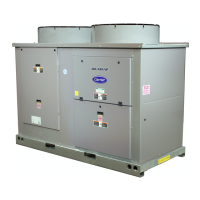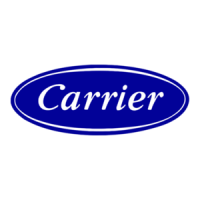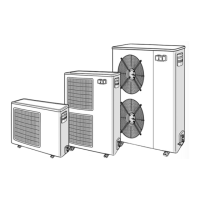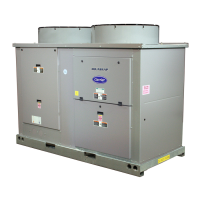94
DISPLAY screen. This provides additional protection against a
loss of water flow condition.
These pressure transducers can be calibrated if necessary. It
is not usually necessary to calibrate at initial start-up.
However, at high altitude locations, it is necessary to calibrate
the transducers to ensure the proper refrigerant temperature/
pressure relationship. Each transducer is supplied with 5 vdc
power from the CCM. If the power supply fails, a transducer
voltage reference alarm occurs. If the transducer reading is
suspected of being faulty, check the TRANSDUCER VOLT-
AGE REF supply voltage. It should be 5 vdc ±.5 v displayed in
CONTROL TEST under CCM PRESSURE TRANSDUC-
ERS. If the TRANSDUCER VOLTAGE REF is correct, the
transducer should be recalibrated or replaced.
Also check that inputs on CCM J5-1 through J5-6 have not
been grounded and are not receiving anything other than a 4 to
20 mA signal.
COOLER CONDENSER PRESSURE TRANSDUCER
AND OPTIONAL WATERSIDE FLOW DEVICE CALI-
BRATION — Calibration can be checked by comparing the
pressure readings from the transducer to an accurate refrigera-
tion gage reading. These readings can be viewed or calibrated
from the HEAT_EX screen on the ICVC. The transducer can
be checked and calibrated at 2 pressure points. These calibra-
tion points are 0 psig (0 kPa) and between 25 and 250 psig
(173 and 1724 kPa). To calibrate these transducers:
1. Shut down the compressor, cooler, and condenser pumps.
NOTE: There should be no flow through the heat
exchangers.
2. Disconnect the transducer in question from its Schrader
fitting for cooler or condenser transducer calibration. For
oil pressure or flow device calibration, leave the transduc-
er in place.
NOTE: If the cooler or condenser vessels are at
0 psig (0 kPa) or are open to atmospheric pressure, the
transducers can be calibrated for zero without remov-
ing the transducer from the vessel.
3. Access the HEAT_EX screen and view the particular
transducer reading (the EVAPORATOR PRESSURE or
CONDENSER PRESSURE parameter on the HEAT_EX
screen). To calibrate oil pressure or liquidside flow
device, view the particular reading (CHILLED WATER
DELTA P and CONDENSER WATER DELTA P on the
HEAT_EX screen, and OIL PUMP DELTA P on the
COMPRESS screen). It should read 0 psi (0 kPa). If the
reading is not 0 psi (0 kPa), but within ± 5 psi (35 kPa),
the value may be set to zero by pressing the
softkey while the appropriate transducer parameter is
highlighted on the ICVC screen. Then press the
softkey. The value will now go to zero. No high end
calibration is necessary for OIL PRESSURE DELTA P or
flow devices.
If the transducer value is not within the calibration
range, the transducer returns to the original reading. If
the pressure is within the allowed range (noted above),
check the voltage ratio of the transducer. To obtain the
voltage ratio, divide the voltage (dc) input from the
transducer by the TRANSDUCER VOLTAGE REF
supply voltage signal (displayed in CONTROL TEST
menu in the PRESSURE TRANSDUCERS screen) or
measure across the positive (+ red) and negative
(– black) leads of the transducer. For example, the
condenser transducer voltage reference is measured
at CCM terminals J2-4 and J2-6, the condenser trans-
ducer voltage input. The input to reference voltage
ratio must be between 0.80 and 0.11 for the software to
allow calibration. Pressurize the transducer until the
ratio is within range. Then attempt calibration again.
4. A high pressure point can also be calibrated between 25
and 250 psig (172.4 and 1723.7 kPa) by attaching a regu-
lated 250 psig (1724 kPa) pressure (usually from a
nitrogen cylinder). The high pressure point can be
calibrated by accessing the appropriate transducer param-
eter on the HEAT_EX screen, highlighting the parameter,
pressing the softkey, and then using the
or softkeys to adjust the
value to the exact pressure on the refrigerant gage. Press
the softkey to finish the calibration. Pressures at
high altitude locations must be compensated for, so the
chiller temperature/pressure relationship is correct.
The PIC III does not allow calibration if the transducer is
too far out of calibration. In this case, a new transducer must be
installed and re-calibrated. If calibration problems are encoun-
tered on the OIL PRESSURE DELTA P channel, sometimes
swapping the compressor oil discharge pressure transducer and
the oil sump pressure transducer will offset an adverse trans-
ducer tolerance stack up and allow the calibration to proceed.
TRANSDUCER REPLACEMENT — Since the transducers
are mounted on Schrader-type fittings, there is no need to
remove refrigerant from the vessel when replacing the trans-
ducers. Disconnect the transducer wiring. Do not pull on the
transducer wires. Unscrew the transducer from the Schrader
fitting. When installing a new transducer, do not use pipe sealer
(which can plug the sensor). Put the plug connector back on the
sensor and snap into place. Check for refrigerant leaks.
Control Algorithms Checkout Procedure —
One of the tables on the ICVC SERVICE menu is CON-
TROL ALGORITHM STATUS. The maintenance screens
may be viewed from the CONTROL ALGORITHM STATUS
table to see how a particular control algorithm is operating.
These maintenance screens show different tables that are
very useful in helping to determine how the control tempera-
ture is calculated and guide vane positioned and also for
observing the reactions from load changes, control point over-
rides, hot gas bypass, surge prevention, etc. See Table 15.
WARNING
Be sure to use a back-up wrench on the Schrader fitting
whenever removing a transducer, since the Schrader fitting
may back out with the transducer, causing an uncontrolled
loss of refrigerant and possible injury to personnel.
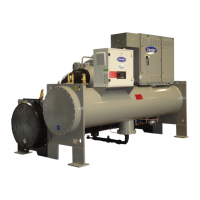
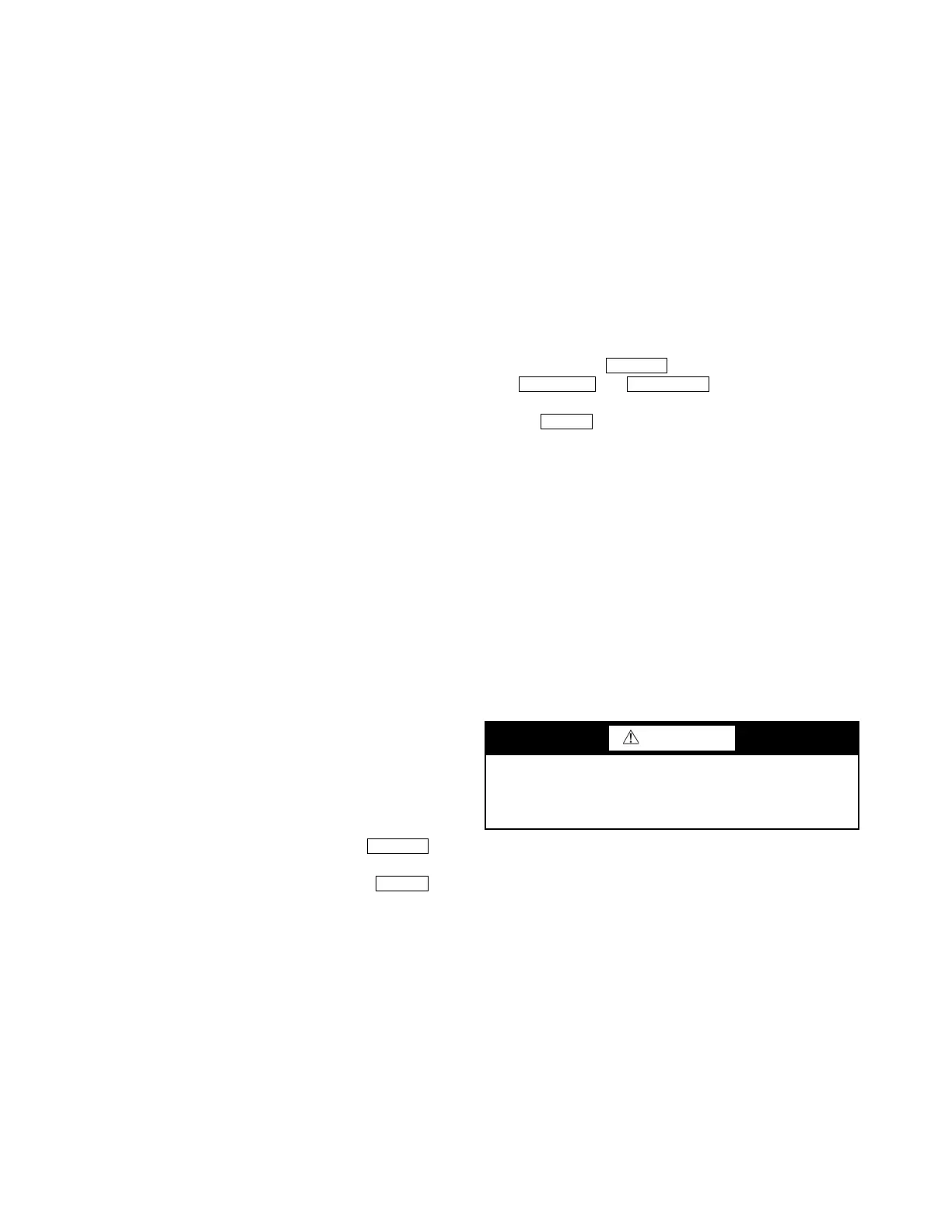